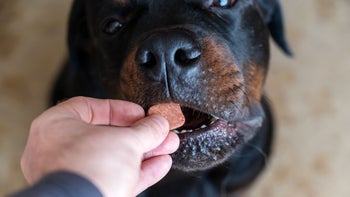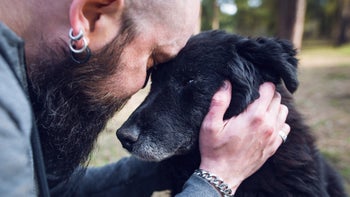
Does Your Dog Have a Stuffy Nose? Signs They’re Congested and How to Help
Key takeaways:
Dogs can get a stuffy nose for a variety of reasons, such as allergies, a bacterial infection, or something getting stuck in their nose.
Spending a few minutes in a steamed room, which you can achieve by running a hot shower, can clear nasal congestion. Just don’t put your dog in the shower itself.
Take your dog to a vet if they don’t get better in 24 to 48 hours, have bloody discharge coming from their nose, or show signs of being in pain.
Table of contents

Just like people, dogs can get stuffy noses from colds, allergies, and other conditions. Unfortunately, your fur baby can’t blow their nose or spray nasal decongestant into their sinuses. So they need your help to feel better.
Below, we’ll review signs your pup has a stuffy nose, why they get congested, and things you can do to help them out.
Symptoms of a stuffy nose in dogs
Here are five common signs of a stuffy nose in dogs.
Save on the top 10 pet medications
Save big on common pet medications like Fluoxetine and Levetiracetam at your local pharmacy.

GoodRx is NOT insurance. GoodRx Health information and resources are reviewed by our editorial staff with medical and healthcare policy and pricing experience. See our editorial policy for more detail. We also provide access to services offered by GoodRx and our partners when we think these services might be useful to our visitors. We may receive compensation when a user decides to leverage these services, but making them available does not influence the medical content our editorial staff provides.
1. Discharge
If you notice gunk coming out of your dog’s nose, something is wrong. This discharge may be yellow, green, clear, white, or brown.
2. Mouth breathing
If your dog is stuffed up, they may breathe through their mouth because they’re not getting enough air through their nose.
3. Snorting or sneezing
If your dog snorts or sneezes, it could be a sign of a cold or allergies.
4. Pawing
A dog with a stuffy nose may paw at their face because they feel pain or discomfort.
5. Eye inflammation
If your dog is congested, their eye area may look puffy and swollen, and they may shed tears.
When to see a vet for your dog’s stuffy nose
Stuffiness is common in dogs and usually not cause for concern. More than likely, a cold or seasonal allergies is what’s causing your dog’s stuffy nose. Worry only if their symptoms don’t clear up in a couple of days or if they show signs that something else is wrong.
Why is your dog drooling? For many dogs, a little slobber is normal. But these symptoms of excessive drooling are cause for concern.
Can your dog catch a cold? Yes, but it’s not what you think. Learn more about colds in dogs and how they differ from human colds.
Drip, drip, drip: Read about runny noses in dogs, and learn what you can do to make them more comfortable.
“If there are any other changes, such as decreased appetite or lethargy, they should be evaluated by a veterinarian right away,” Danielle Williams, DVM, DACVECC, told GoodRx Health. Williams is a veterinarian for VCA Highlands Ranch Animal Specialty & Emergency Center.
Also go to the vet if any of the following happens:
Your dog’s stuffy nose doesn’t improve on its own within 24 to 48 hours.
Your pup has bloody nasal discharge.
Your dog appears to be in pain (e.g., pawing at their muzzle, whining, hiding).
You suspect there’s a foreign object stuck in your dog’s nose.
Read more like this
Explore these related articles, suggested for readers like you.
How to treat congestion in dogs
If your dog’s stuffy nose doesn’t improve, take them to the vet. A vet can diagnose the underlying cause of their nasal congestion. The best treatment for your dog will depend on the cause of their symptoms.
“Congestion can be due to a virus, bacterium, or other etiologies, such as immune-mediated disease, foreign bodies, or nasal tumors,” Williams said.
Your veterinarian may recommend treating your dog’s stuffy nose with medication. This can help with underlying infections or inflammation that can cause a stuffy nose. Examples of medications your vet may prescribe include:
Antibiotics: Doxycycline, enrofloxacin, amoxicillin / clavulanate (Clavamox), azithromycin
Antivirals: famciclovir
Anti-inflammatories: prednisone, carprofen, grapiprant (Galliprant), meloxicam
Don’t use over-the-counter medications to treat your dog’s stuffy nose without first talking to your veterinarian. Also, don’t put Vicks VapoRub (or similar products) on your dog. Vicks VapoRub contains the ingredient camphor, which is toxic to dogs and can lead to poisoning.
Are there at-home remedies to help your dog with congestion?
There are several things you can do to make your dog more comfortable when they have a stuffy nose. There are also things you shouldn’t do.
First, don’t try to flush out your dog’s nose with fluids, medications, or devices without your vet’s guidance. Also, keep the air free of smoke and chemicals to prevent further congestion.
You can also try using steam to reduce your dog’s congestion. Place your dog in a steamed room, such as a bathroom, for 5 to 10 minutes a few times a day. To create the steam, run a hot shower. But don’t put your pup in the shower.
“Steam from the shower can open up congested airways and help drain more discharge to aid in breathing,” Williams said.
What causes a stuffy nose for dogs?
Rhinitis and sinusitis are two of the most common causes of stuffiness in dogs. Rhinitis is the inflammation of the mucous membranes in the nose. Sinusitis is inflammation of the lining of the sinuses.
Sometimes rhinitis and sinusitis come on suddenly. This often happens with a viral infection such as distemper, adenovirus type 1 and type 2, and parainfluenza. These viruses usually cause a bacterial infection to develop.
Other reasons your dog may have sudden stuffiness include:
Seasonal allergies
Breathing in smoke or harmful gasses
A foreign object stuck in their nose
If your dog’s congestion lasts longer than 2 weeks, it’s considered chronic, Williams said. If your dog has a chronic stuffy nose, there could be other potential causes.
Causes for long-term stuffiness include:
Chronic inflammatory disease, like lymphoplasmacytic rhinitis
Trauma
Parasites
A tumor
A birth defect
Certain breeds are at higher risk for nasal diseases that can cause congestion. For example:
Brachycephalic, or flat-faced, breeds like boxers and Pekingese may struggle to clear their sinuses.
Dogs with medium-size or long faces like beagles and greyhounds may be prone to rhinomycosis, a fungal condition.
Dachshunds and Irish wolfhounds may be more likely to get hyperplastic rhinitis, a chronic nasal disease.
Frequently asked questions
Veterinarians don’t typically prescribe Benadryl (diphenhydramine) to treat a stuffy nose in dogs. In dogs, the medication is frequently used for itchy skin from allergies, motion sickness, and mast cell tumors.
A dog who has something stuck in their nose may show the following signs:
Sneezing
Pawing at their nose
Swelling
Snorting
Bloody nose
Discharge
You can give your dog a saline nasal spray or a pediatric nasal spray like Little Noses to relieve nasal congestion. But it’s best to ask your veterinarian if this is safe for your dog.
If stuffiness lasts more than a couple of days, take your dog to a veterinarian. They may treat your dog with antibiotics, antivirals, or anti-inflammatories, depending on the cause.
The bottom line
Dogs can get stuffy noses just as people do. Their stuffy noses are often caused by a cold or allergies. You can treat your dog’s stuffy nose at home by placing them in a bathroom with a hot shower running. But if things don’t clear up after a day or two, it’s best to see a vet.
A vet can tell you if there’s something else going on with your dog, like a fungal infection or something stuck in their nose. Whatever you do, don’t try to flush out your dog’s nose or give them medication without talking to your vet first.
Why trust our experts?



References
Cox, C. L. (2003). Diagnosis of nasal disease in the dog. World Small Animal Veterinary Association.
Kuehn, N. F. (2024). Rhinitis and sinusitis in dogs. Merck Veterinary Manual.
Lobetti, R. (2014). Idiopathic lymphoplasmacytic rhinitis in 33 dogs. Journal of the South African Veterinary Association.
Lundgren, B. (2023). Rhinitis in dogs and cats. Veterinary Partner.
Young, A. (2023). Brachycephalic (short-nosed) dogs. University of California, Davis, School of Veterinary Medicine.


























